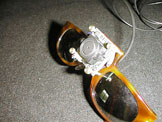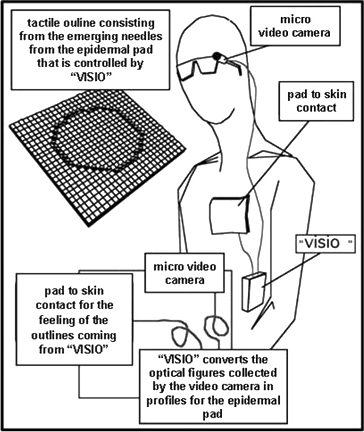  VISIO is our vision system that was created for industrial robotics. When Visio is applied to humans becomes a device capable of converting a tactile image from an image captured by a camera. VISIO allows a blind person to “feel”, to recognize objects that are in its movement area through the skin stimulation. A micro-camera, in the center of a sunglasses, sends its signal to the hardware system that extrapolates the outlines, after which the signal by proper devices it is sent to haptic interface composed by an array of 400 dynamic pins that impressing the outlines of the object framed. The array is placed, on the abdomen skin of a blind person, through a harness . He perceives the movement of pins dynamically and relatively to the movements of his head. In fact, the micro-camera window is very narrow, so that the framed object can stay consistent to its size. It is the movement of the head that “draws” in the mind of a blind person the size of the frame, while the haptic interface keeps consistency, while the micro-camera is scanning. All the actions produced by the dynamic movement of the head, of the body and by the mixed of signals coming from other senses: proprioception, balance, hearing, touch, smell and taste, allow the blind to have a mental picture of the environment surrounding, which in this case is captured by the camera. So it is no longer the blind person that needs to reach out the objects, but the latter have taken another perceptive input way that is the tactile abdomen (haptic interface). VISIO is our vision system that was created for industrial robotics. When Visio is applied to humans becomes a device capable of converting a tactile image from an image captured by a camera. VISIO allows a blind person to “feel”, to recognize objects that are in its movement area through the skin stimulation. A micro-camera, in the center of a sunglasses, sends its signal to the hardware system that extrapolates the outlines, after which the signal by proper devices it is sent to haptic interface composed by an array of 400 dynamic pins that impressing the outlines of the object framed. The array is placed, on the abdomen skin of a blind person, through a harness . He perceives the movement of pins dynamically and relatively to the movements of his head. In fact, the micro-camera window is very narrow, so that the framed object can stay consistent to its size. It is the movement of the head that “draws” in the mind of a blind person the size of the frame, while the haptic interface keeps consistency, while the micro-camera is scanning. All the actions produced by the dynamic movement of the head, of the body and by the mixed of signals coming from other senses: proprioception, balance, hearing, touch, smell and taste, allow the blind to have a mental picture of the environment surrounding, which in this case is captured by the camera. So it is no longer the blind person that needs to reach out the objects, but the latter have taken another perceptive input way that is the tactile abdomen (haptic interface). |
|
Copyright © 2015 Controluce - link a Notizie in... Controluce - link al sito dell'ENEA |
|

